Financial Accounting Report: Legal and Regulatory Framework Impact
VerifiedAdded on 2020/01/28
|17
|5098
|327
Report
AI Summary
This report delves into the realm of financial accounting, dissecting the influence of legal and regulatory frameworks on the preparation and interpretation of financial statements. The report meticulously examines key components such as the Companies Act 2006, Generally Accepted Accounting Principles (GAAP), International Accounting Standards (IAS), and International Financial Reporting Standards (IFRS). It elucidates the implications of these frameworks for various users, including managers, employees, investors, and lenders, highlighting their respective information needs. Furthermore, the report addresses specific accounting tasks, including the impact of legal and regulatory frameworks on financial statements, and provides practical examples, such as the preparation of financial statements for Atlas plc and the impact of share issuance on financial metrics.
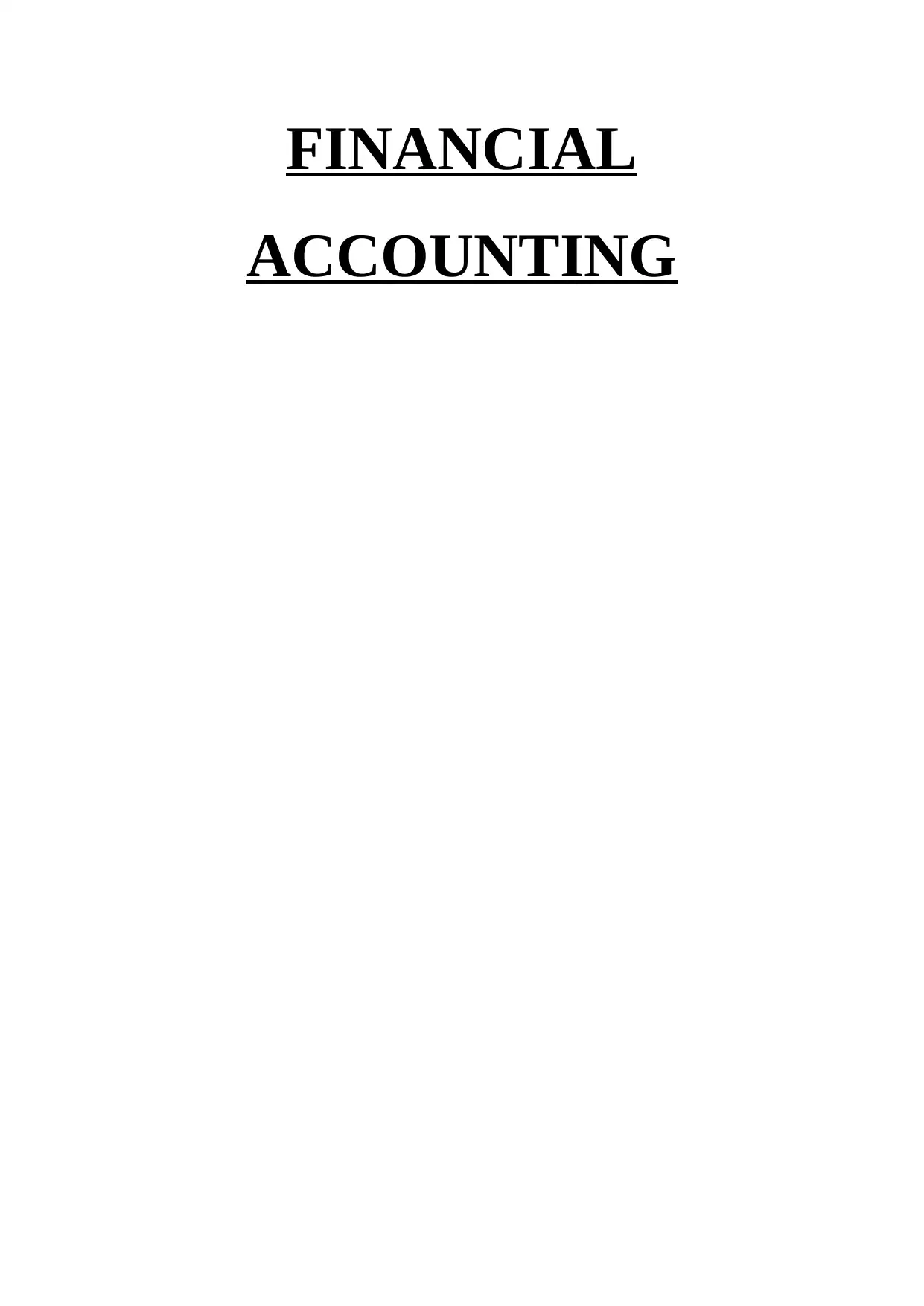
FINANCIAL
ACCOUNTING
ACCOUNTING
Paraphrase This Document
Need a fresh take? Get an instant paraphrase of this document with our AI Paraphraser
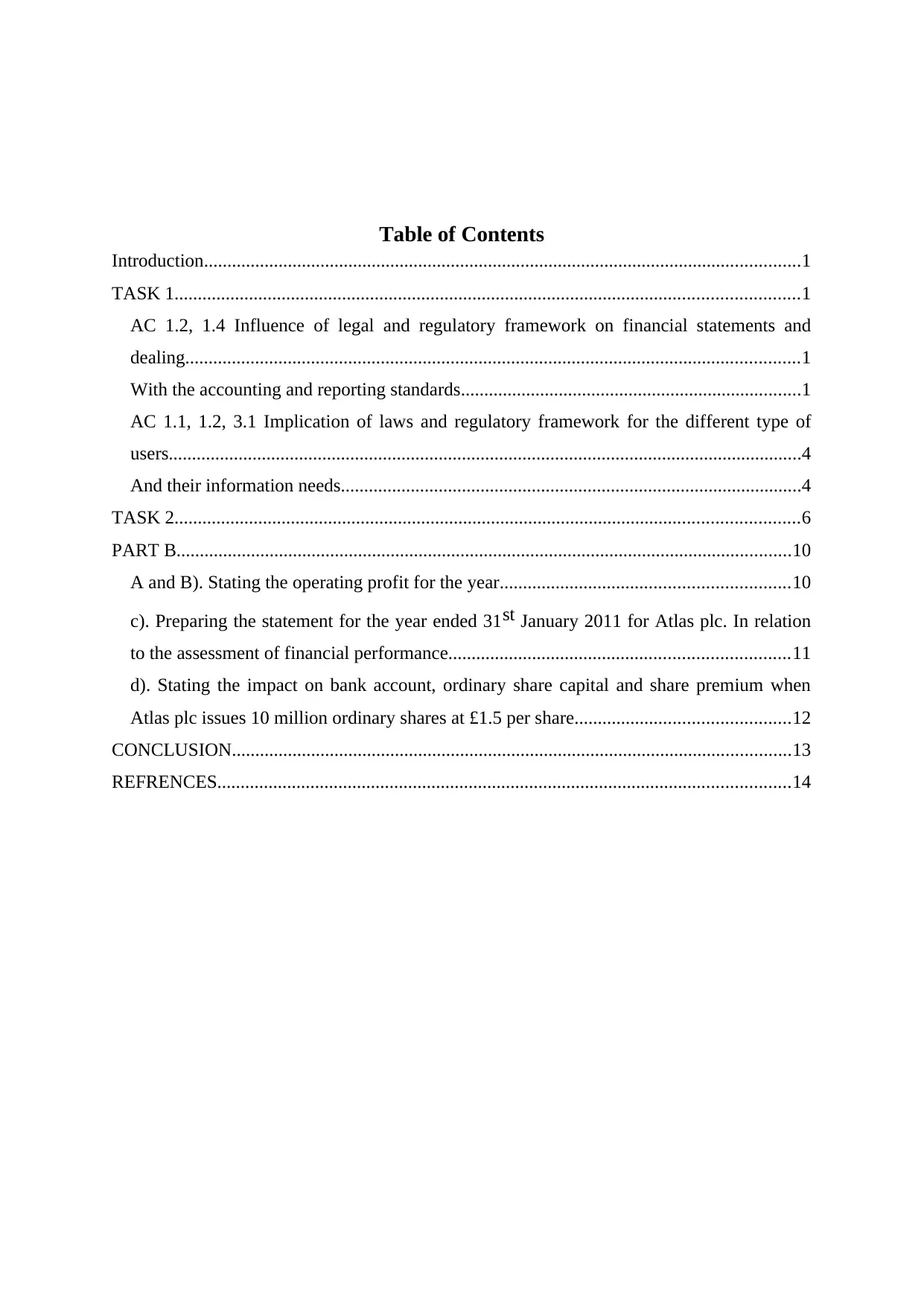
Table of Contents
Introduction................................................................................................................................1
TASK 1......................................................................................................................................1
AC 1.2, 1.4 Influence of legal and regulatory framework on financial statements and
dealing....................................................................................................................................1
With the accounting and reporting standards.........................................................................1
AC 1.1, 1.2, 3.1 Implication of laws and regulatory framework for the different type of
users........................................................................................................................................4
And their information needs...................................................................................................4
TASK 2......................................................................................................................................6
PART B....................................................................................................................................10
A and B). Stating the operating profit for the year..............................................................10
c). Preparing the statement for the year ended 31st January 2011 for Atlas plc. In relation
to the assessment of financial performance.........................................................................11
d). Stating the impact on bank account, ordinary share capital and share premium when
Atlas plc issues 10 million ordinary shares at £1.5 per share..............................................12
CONCLUSION........................................................................................................................13
REFRENCES...........................................................................................................................14
Introduction................................................................................................................................1
TASK 1......................................................................................................................................1
AC 1.2, 1.4 Influence of legal and regulatory framework on financial statements and
dealing....................................................................................................................................1
With the accounting and reporting standards.........................................................................1
AC 1.1, 1.2, 3.1 Implication of laws and regulatory framework for the different type of
users........................................................................................................................................4
And their information needs...................................................................................................4
TASK 2......................................................................................................................................6
PART B....................................................................................................................................10
A and B). Stating the operating profit for the year..............................................................10
c). Preparing the statement for the year ended 31st January 2011 for Atlas plc. In relation
to the assessment of financial performance.........................................................................11
d). Stating the impact on bank account, ordinary share capital and share premium when
Atlas plc issues 10 million ordinary shares at £1.5 per share..............................................12
CONCLUSION........................................................................................................................13
REFRENCES...........................................................................................................................14
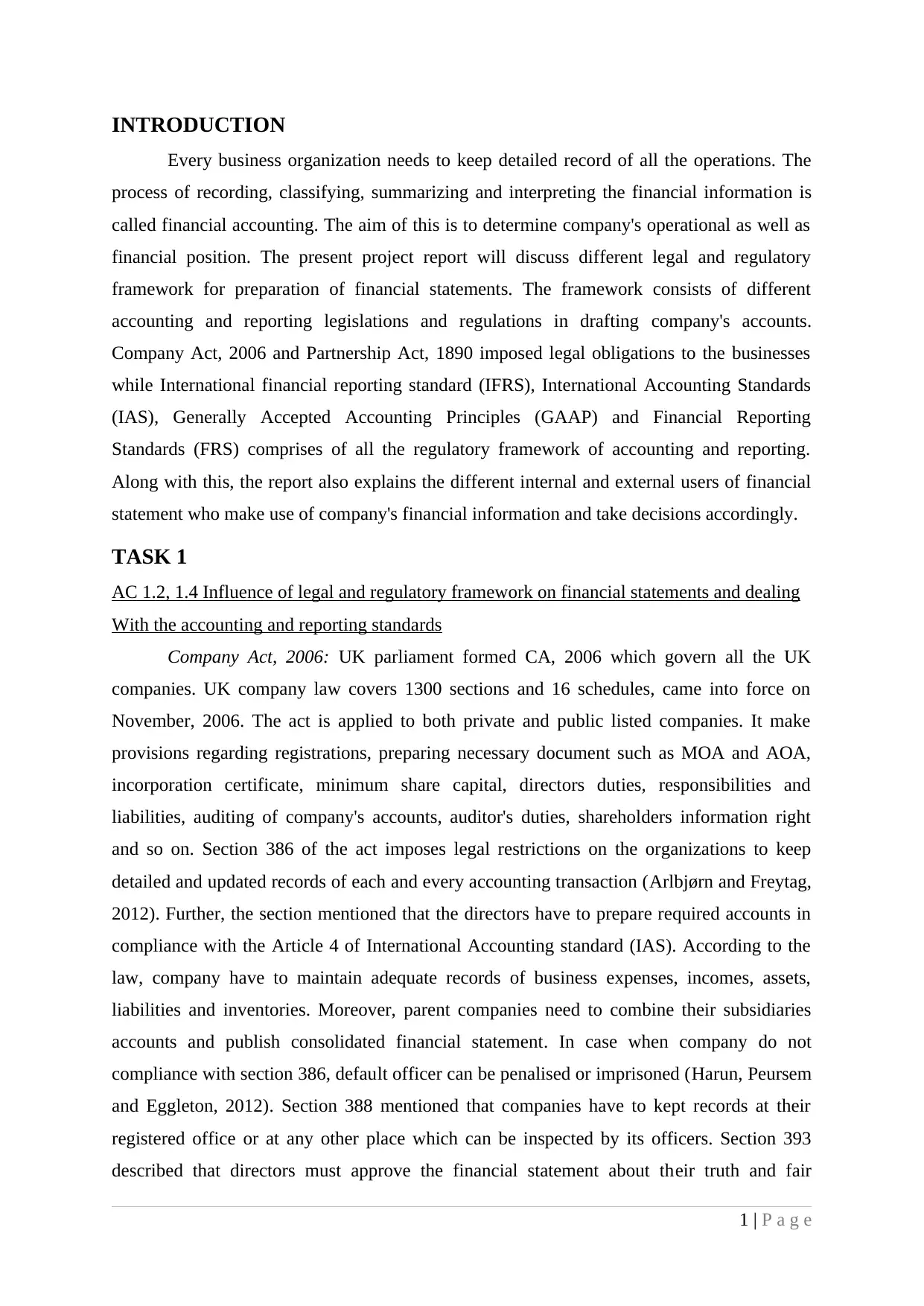
INTRODUCTION
Every business organization needs to keep detailed record of all the operations. The
process of recording, classifying, summarizing and interpreting the financial information is
called financial accounting. The aim of this is to determine company's operational as well as
financial position. The present project report will discuss different legal and regulatory
framework for preparation of financial statements. The framework consists of different
accounting and reporting legislations and regulations in drafting company's accounts.
Company Act, 2006 and Partnership Act, 1890 imposed legal obligations to the businesses
while International financial reporting standard (IFRS), International Accounting Standards
(IAS), Generally Accepted Accounting Principles (GAAP) and Financial Reporting
Standards (FRS) comprises of all the regulatory framework of accounting and reporting.
Along with this, the report also explains the different internal and external users of financial
statement who make use of company's financial information and take decisions accordingly.
TASK 1
AC 1.2, 1.4 Influence of legal and regulatory framework on financial statements and dealing
With the accounting and reporting standards
Company Act, 2006: UK parliament formed CA, 2006 which govern all the UK
companies. UK company law covers 1300 sections and 16 schedules, came into force on
November, 2006. The act is applied to both private and public listed companies. It make
provisions regarding registrations, preparing necessary document such as MOA and AOA,
incorporation certificate, minimum share capital, directors duties, responsibilities and
liabilities, auditing of company's accounts, auditor's duties, shareholders information right
and so on. Section 386 of the act imposes legal restrictions on the organizations to keep
detailed and updated records of each and every accounting transaction (Arlbjørn and Freytag,
2012). Further, the section mentioned that the directors have to prepare required accounts in
compliance with the Article 4 of International Accounting standard (IAS). According to the
law, company have to maintain adequate records of business expenses, incomes, assets,
liabilities and inventories. Moreover, parent companies need to combine their subsidiaries
accounts and publish consolidated financial statement. In case when company do not
compliance with section 386, default officer can be penalised or imprisoned (Harun, Peursem
and Eggleton, 2012). Section 388 mentioned that companies have to kept records at their
registered office or at any other place which can be inspected by its officers. Section 393
described that directors must approve the financial statement about their truth and fair
1 | P a g e
Every business organization needs to keep detailed record of all the operations. The
process of recording, classifying, summarizing and interpreting the financial information is
called financial accounting. The aim of this is to determine company's operational as well as
financial position. The present project report will discuss different legal and regulatory
framework for preparation of financial statements. The framework consists of different
accounting and reporting legislations and regulations in drafting company's accounts.
Company Act, 2006 and Partnership Act, 1890 imposed legal obligations to the businesses
while International financial reporting standard (IFRS), International Accounting Standards
(IAS), Generally Accepted Accounting Principles (GAAP) and Financial Reporting
Standards (FRS) comprises of all the regulatory framework of accounting and reporting.
Along with this, the report also explains the different internal and external users of financial
statement who make use of company's financial information and take decisions accordingly.
TASK 1
AC 1.2, 1.4 Influence of legal and regulatory framework on financial statements and dealing
With the accounting and reporting standards
Company Act, 2006: UK parliament formed CA, 2006 which govern all the UK
companies. UK company law covers 1300 sections and 16 schedules, came into force on
November, 2006. The act is applied to both private and public listed companies. It make
provisions regarding registrations, preparing necessary document such as MOA and AOA,
incorporation certificate, minimum share capital, directors duties, responsibilities and
liabilities, auditing of company's accounts, auditor's duties, shareholders information right
and so on. Section 386 of the act imposes legal restrictions on the organizations to keep
detailed and updated records of each and every accounting transaction (Arlbjørn and Freytag,
2012). Further, the section mentioned that the directors have to prepare required accounts in
compliance with the Article 4 of International Accounting standard (IAS). According to the
law, company have to maintain adequate records of business expenses, incomes, assets,
liabilities and inventories. Moreover, parent companies need to combine their subsidiaries
accounts and publish consolidated financial statement. In case when company do not
compliance with section 386, default officer can be penalised or imprisoned (Harun, Peursem
and Eggleton, 2012). Section 388 mentioned that companies have to kept records at their
registered office or at any other place which can be inspected by its officers. Section 393
described that directors must approve the financial statement about their truth and fair
1 | P a g e
⊘ This is a preview!⊘
Do you want full access?
Subscribe today to unlock all pages.

Trusted by 1+ million students worldwide
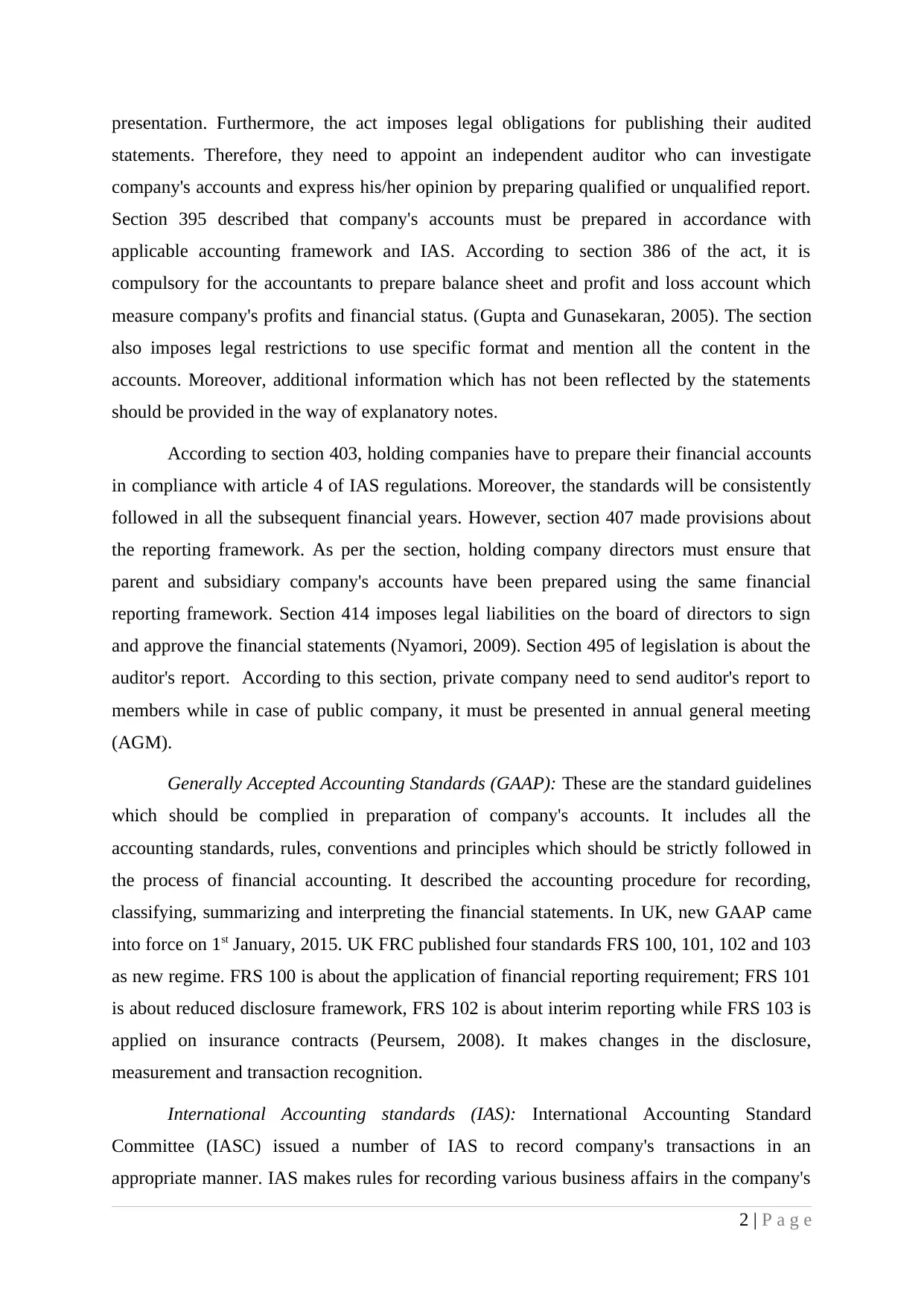
presentation. Furthermore, the act imposes legal obligations for publishing their audited
statements. Therefore, they need to appoint an independent auditor who can investigate
company's accounts and express his/her opinion by preparing qualified or unqualified report.
Section 395 described that company's accounts must be prepared in accordance with
applicable accounting framework and IAS. According to section 386 of the act, it is
compulsory for the accountants to prepare balance sheet and profit and loss account which
measure company's profits and financial status. (Gupta and Gunasekaran, 2005). The section
also imposes legal restrictions to use specific format and mention all the content in the
accounts. Moreover, additional information which has not been reflected by the statements
should be provided in the way of explanatory notes.
According to section 403, holding companies have to prepare their financial accounts
in compliance with article 4 of IAS regulations. Moreover, the standards will be consistently
followed in all the subsequent financial years. However, section 407 made provisions about
the reporting framework. As per the section, holding company directors must ensure that
parent and subsidiary company's accounts have been prepared using the same financial
reporting framework. Section 414 imposes legal liabilities on the board of directors to sign
and approve the financial statements (Nyamori, 2009). Section 495 of legislation is about the
auditor's report. According to this section, private company need to send auditor's report to
members while in case of public company, it must be presented in annual general meeting
(AGM).
Generally Accepted Accounting Standards (GAAP): These are the standard guidelines
which should be complied in preparation of company's accounts. It includes all the
accounting standards, rules, conventions and principles which should be strictly followed in
the process of financial accounting. It described the accounting procedure for recording,
classifying, summarizing and interpreting the financial statements. In UK, new GAAP came
into force on 1st January, 2015. UK FRC published four standards FRS 100, 101, 102 and 103
as new regime. FRS 100 is about the application of financial reporting requirement; FRS 101
is about reduced disclosure framework, FRS 102 is about interim reporting while FRS 103 is
applied on insurance contracts (Peursem, 2008). It makes changes in the disclosure,
measurement and transaction recognition.
International Accounting standards (IAS): International Accounting Standard
Committee (IASC) issued a number of IAS to record company's transactions in an
appropriate manner. IAS makes rules for recording various business affairs in the company's
2 | P a g e
statements. Therefore, they need to appoint an independent auditor who can investigate
company's accounts and express his/her opinion by preparing qualified or unqualified report.
Section 395 described that company's accounts must be prepared in accordance with
applicable accounting framework and IAS. According to section 386 of the act, it is
compulsory for the accountants to prepare balance sheet and profit and loss account which
measure company's profits and financial status. (Gupta and Gunasekaran, 2005). The section
also imposes legal restrictions to use specific format and mention all the content in the
accounts. Moreover, additional information which has not been reflected by the statements
should be provided in the way of explanatory notes.
According to section 403, holding companies have to prepare their financial accounts
in compliance with article 4 of IAS regulations. Moreover, the standards will be consistently
followed in all the subsequent financial years. However, section 407 made provisions about
the reporting framework. As per the section, holding company directors must ensure that
parent and subsidiary company's accounts have been prepared using the same financial
reporting framework. Section 414 imposes legal liabilities on the board of directors to sign
and approve the financial statements (Nyamori, 2009). Section 495 of legislation is about the
auditor's report. According to this section, private company need to send auditor's report to
members while in case of public company, it must be presented in annual general meeting
(AGM).
Generally Accepted Accounting Standards (GAAP): These are the standard guidelines
which should be complied in preparation of company's accounts. It includes all the
accounting standards, rules, conventions and principles which should be strictly followed in
the process of financial accounting. It described the accounting procedure for recording,
classifying, summarizing and interpreting the financial statements. In UK, new GAAP came
into force on 1st January, 2015. UK FRC published four standards FRS 100, 101, 102 and 103
as new regime. FRS 100 is about the application of financial reporting requirement; FRS 101
is about reduced disclosure framework, FRS 102 is about interim reporting while FRS 103 is
applied on insurance contracts (Peursem, 2008). It makes changes in the disclosure,
measurement and transaction recognition.
International Accounting standards (IAS): International Accounting Standard
Committee (IASC) issued a number of IAS to record company's transactions in an
appropriate manner. IAS makes rules for recording various business affairs in the company's
2 | P a g e
Paraphrase This Document
Need a fresh take? Get an instant paraphrase of this document with our AI Paraphraser
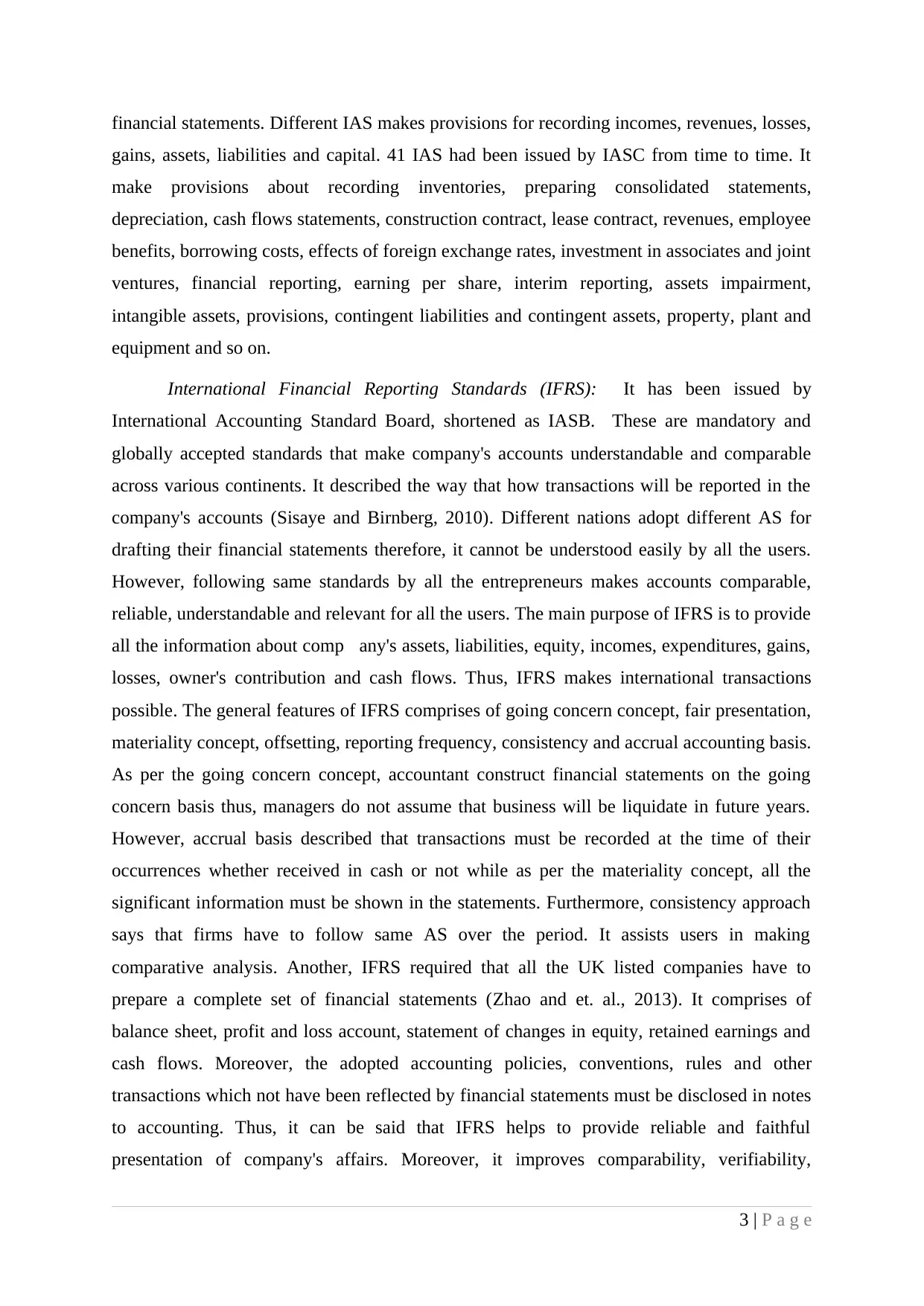
financial statements. Different IAS makes provisions for recording incomes, revenues, losses,
gains, assets, liabilities and capital. 41 IAS had been issued by IASC from time to time. It
make provisions about recording inventories, preparing consolidated statements,
depreciation, cash flows statements, construction contract, lease contract, revenues, employee
benefits, borrowing costs, effects of foreign exchange rates, investment in associates and joint
ventures, financial reporting, earning per share, interim reporting, assets impairment,
intangible assets, provisions, contingent liabilities and contingent assets, property, plant and
equipment and so on.
International Financial Reporting Standards (IFRS): It has been issued by
International Accounting Standard Board, shortened as IASB. These are mandatory and
globally accepted standards that make company's accounts understandable and comparable
across various continents. It described the way that how transactions will be reported in the
company's accounts (Sisaye and Birnberg, 2010). Different nations adopt different AS for
drafting their financial statements therefore, it cannot be understood easily by all the users.
However, following same standards by all the entrepreneurs makes accounts comparable,
reliable, understandable and relevant for all the users. The main purpose of IFRS is to provide
all the information about comp any's assets, liabilities, equity, incomes, expenditures, gains,
losses, owner's contribution and cash flows. Thus, IFRS makes international transactions
possible. The general features of IFRS comprises of going concern concept, fair presentation,
materiality concept, offsetting, reporting frequency, consistency and accrual accounting basis.
As per the going concern concept, accountant construct financial statements on the going
concern basis thus, managers do not assume that business will be liquidate in future years.
However, accrual basis described that transactions must be recorded at the time of their
occurrences whether received in cash or not while as per the materiality concept, all the
significant information must be shown in the statements. Furthermore, consistency approach
says that firms have to follow same AS over the period. It assists users in making
comparative analysis. Another, IFRS required that all the UK listed companies have to
prepare a complete set of financial statements (Zhao and et. al., 2013). It comprises of
balance sheet, profit and loss account, statement of changes in equity, retained earnings and
cash flows. Moreover, the adopted accounting policies, conventions, rules and other
transactions which not have been reflected by financial statements must be disclosed in notes
to accounting. Thus, it can be said that IFRS helps to provide reliable and faithful
presentation of company's affairs. Moreover, it improves comparability, verifiability,
3 | P a g e
gains, assets, liabilities and capital. 41 IAS had been issued by IASC from time to time. It
make provisions about recording inventories, preparing consolidated statements,
depreciation, cash flows statements, construction contract, lease contract, revenues, employee
benefits, borrowing costs, effects of foreign exchange rates, investment in associates and joint
ventures, financial reporting, earning per share, interim reporting, assets impairment,
intangible assets, provisions, contingent liabilities and contingent assets, property, plant and
equipment and so on.
International Financial Reporting Standards (IFRS): It has been issued by
International Accounting Standard Board, shortened as IASB. These are mandatory and
globally accepted standards that make company's accounts understandable and comparable
across various continents. It described the way that how transactions will be reported in the
company's accounts (Sisaye and Birnberg, 2010). Different nations adopt different AS for
drafting their financial statements therefore, it cannot be understood easily by all the users.
However, following same standards by all the entrepreneurs makes accounts comparable,
reliable, understandable and relevant for all the users. The main purpose of IFRS is to provide
all the information about comp any's assets, liabilities, equity, incomes, expenditures, gains,
losses, owner's contribution and cash flows. Thus, IFRS makes international transactions
possible. The general features of IFRS comprises of going concern concept, fair presentation,
materiality concept, offsetting, reporting frequency, consistency and accrual accounting basis.
As per the going concern concept, accountant construct financial statements on the going
concern basis thus, managers do not assume that business will be liquidate in future years.
However, accrual basis described that transactions must be recorded at the time of their
occurrences whether received in cash or not while as per the materiality concept, all the
significant information must be shown in the statements. Furthermore, consistency approach
says that firms have to follow same AS over the period. It assists users in making
comparative analysis. Another, IFRS required that all the UK listed companies have to
prepare a complete set of financial statements (Zhao and et. al., 2013). It comprises of
balance sheet, profit and loss account, statement of changes in equity, retained earnings and
cash flows. Moreover, the adopted accounting policies, conventions, rules and other
transactions which not have been reflected by financial statements must be disclosed in notes
to accounting. Thus, it can be said that IFRS helps to provide reliable and faithful
presentation of company's affairs. Moreover, it improves comparability, verifiability,
3 | P a g e
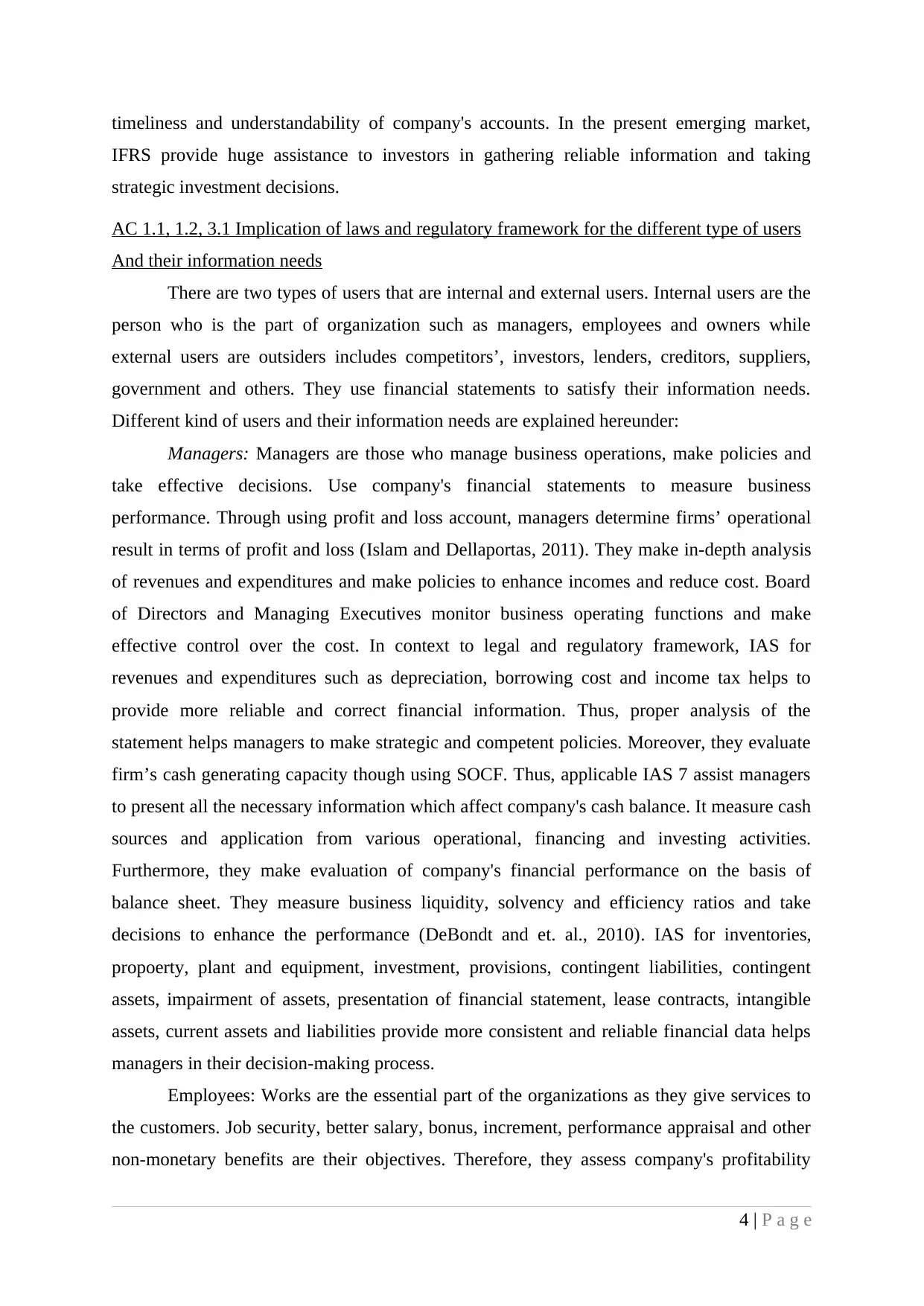
timeliness and understandability of company's accounts. In the present emerging market,
IFRS provide huge assistance to investors in gathering reliable information and taking
strategic investment decisions.
AC 1.1, 1.2, 3.1 Implication of laws and regulatory framework for the different type of users
And their information needs
There are two types of users that are internal and external users. Internal users are the
person who is the part of organization such as managers, employees and owners while
external users are outsiders includes competitors’, investors, lenders, creditors, suppliers,
government and others. They use financial statements to satisfy their information needs.
Different kind of users and their information needs are explained hereunder:
Managers: Managers are those who manage business operations, make policies and
take effective decisions. Use company's financial statements to measure business
performance. Through using profit and loss account, managers determine firms’ operational
result in terms of profit and loss (Islam and Dellaportas, 2011). They make in-depth analysis
of revenues and expenditures and make policies to enhance incomes and reduce cost. Board
of Directors and Managing Executives monitor business operating functions and make
effective control over the cost. In context to legal and regulatory framework, IAS for
revenues and expenditures such as depreciation, borrowing cost and income tax helps to
provide more reliable and correct financial information. Thus, proper analysis of the
statement helps managers to make strategic and competent policies. Moreover, they evaluate
firm’s cash generating capacity though using SOCF. Thus, applicable IAS 7 assist managers
to present all the necessary information which affect company's cash balance. It measure cash
sources and application from various operational, financing and investing activities.
Furthermore, they make evaluation of company's financial performance on the basis of
balance sheet. They measure business liquidity, solvency and efficiency ratios and take
decisions to enhance the performance (DeBondt and et. al., 2010). IAS for inventories,
propoerty, plant and equipment, investment, provisions, contingent liabilities, contingent
assets, impairment of assets, presentation of financial statement, lease contracts, intangible
assets, current assets and liabilities provide more consistent and reliable financial data helps
managers in their decision-making process.
Employees: Works are the essential part of the organizations as they give services to
the customers. Job security, better salary, bonus, increment, performance appraisal and other
non-monetary benefits are their objectives. Therefore, they assess company's profitability
4 | P a g e
IFRS provide huge assistance to investors in gathering reliable information and taking
strategic investment decisions.
AC 1.1, 1.2, 3.1 Implication of laws and regulatory framework for the different type of users
And their information needs
There are two types of users that are internal and external users. Internal users are the
person who is the part of organization such as managers, employees and owners while
external users are outsiders includes competitors’, investors, lenders, creditors, suppliers,
government and others. They use financial statements to satisfy their information needs.
Different kind of users and their information needs are explained hereunder:
Managers: Managers are those who manage business operations, make policies and
take effective decisions. Use company's financial statements to measure business
performance. Through using profit and loss account, managers determine firms’ operational
result in terms of profit and loss (Islam and Dellaportas, 2011). They make in-depth analysis
of revenues and expenditures and make policies to enhance incomes and reduce cost. Board
of Directors and Managing Executives monitor business operating functions and make
effective control over the cost. In context to legal and regulatory framework, IAS for
revenues and expenditures such as depreciation, borrowing cost and income tax helps to
provide more reliable and correct financial information. Thus, proper analysis of the
statement helps managers to make strategic and competent policies. Moreover, they evaluate
firm’s cash generating capacity though using SOCF. Thus, applicable IAS 7 assist managers
to present all the necessary information which affect company's cash balance. It measure cash
sources and application from various operational, financing and investing activities.
Furthermore, they make evaluation of company's financial performance on the basis of
balance sheet. They measure business liquidity, solvency and efficiency ratios and take
decisions to enhance the performance (DeBondt and et. al., 2010). IAS for inventories,
propoerty, plant and equipment, investment, provisions, contingent liabilities, contingent
assets, impairment of assets, presentation of financial statement, lease contracts, intangible
assets, current assets and liabilities provide more consistent and reliable financial data helps
managers in their decision-making process.
Employees: Works are the essential part of the organizations as they give services to
the customers. Job security, better salary, bonus, increment, performance appraisal and other
non-monetary benefits are their objectives. Therefore, they assess company's profitability
4 | P a g e
⊘ This is a preview!⊘
Do you want full access?
Subscribe today to unlock all pages.

Trusted by 1+ million students worldwide
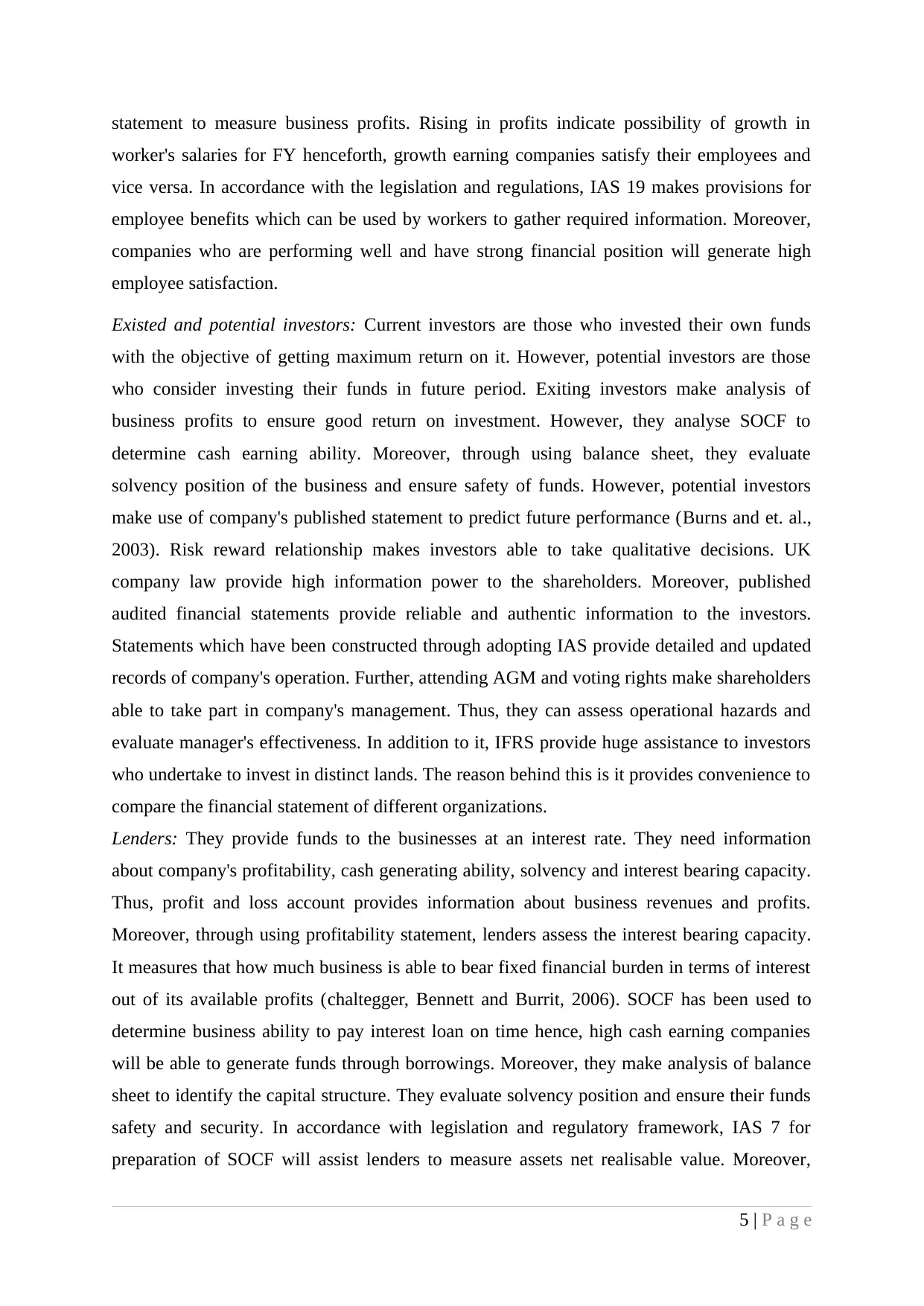
statement to measure business profits. Rising in profits indicate possibility of growth in
worker's salaries for FY henceforth, growth earning companies satisfy their employees and
vice versa. In accordance with the legislation and regulations, IAS 19 makes provisions for
employee benefits which can be used by workers to gather required information. Moreover,
companies who are performing well and have strong financial position will generate high
employee satisfaction.
Existed and potential investors: Current investors are those who invested their own funds
with the objective of getting maximum return on it. However, potential investors are those
who consider investing their funds in future period. Exiting investors make analysis of
business profits to ensure good return on investment. However, they analyse SOCF to
determine cash earning ability. Moreover, through using balance sheet, they evaluate
solvency position of the business and ensure safety of funds. However, potential investors
make use of company's published statement to predict future performance (Burns and et. al.,
2003). Risk reward relationship makes investors able to take qualitative decisions. UK
company law provide high information power to the shareholders. Moreover, published
audited financial statements provide reliable and authentic information to the investors.
Statements which have been constructed through adopting IAS provide detailed and updated
records of company's operation. Further, attending AGM and voting rights make shareholders
able to take part in company's management. Thus, they can assess operational hazards and
evaluate manager's effectiveness. In addition to it, IFRS provide huge assistance to investors
who undertake to invest in distinct lands. The reason behind this is it provides convenience to
compare the financial statement of different organizations.
Lenders: They provide funds to the businesses at an interest rate. They need information
about company's profitability, cash generating ability, solvency and interest bearing capacity.
Thus, profit and loss account provides information about business revenues and profits.
Moreover, through using profitability statement, lenders assess the interest bearing capacity.
It measures that how much business is able to bear fixed financial burden in terms of interest
out of its available profits (chaltegger, Bennett and Burrit, 2006). SOCF has been used to
determine business ability to pay interest loan on time hence, high cash earning companies
will be able to generate funds through borrowings. Moreover, they make analysis of balance
sheet to identify the capital structure. They evaluate solvency position and ensure their funds
safety and security. In accordance with legislation and regulatory framework, IAS 7 for
preparation of SOCF will assist lenders to measure assets net realisable value. Moreover,
5 | P a g e
worker's salaries for FY henceforth, growth earning companies satisfy their employees and
vice versa. In accordance with the legislation and regulations, IAS 19 makes provisions for
employee benefits which can be used by workers to gather required information. Moreover,
companies who are performing well and have strong financial position will generate high
employee satisfaction.
Existed and potential investors: Current investors are those who invested their own funds
with the objective of getting maximum return on it. However, potential investors are those
who consider investing their funds in future period. Exiting investors make analysis of
business profits to ensure good return on investment. However, they analyse SOCF to
determine cash earning ability. Moreover, through using balance sheet, they evaluate
solvency position of the business and ensure safety of funds. However, potential investors
make use of company's published statement to predict future performance (Burns and et. al.,
2003). Risk reward relationship makes investors able to take qualitative decisions. UK
company law provide high information power to the shareholders. Moreover, published
audited financial statements provide reliable and authentic information to the investors.
Statements which have been constructed through adopting IAS provide detailed and updated
records of company's operation. Further, attending AGM and voting rights make shareholders
able to take part in company's management. Thus, they can assess operational hazards and
evaluate manager's effectiveness. In addition to it, IFRS provide huge assistance to investors
who undertake to invest in distinct lands. The reason behind this is it provides convenience to
compare the financial statement of different organizations.
Lenders: They provide funds to the businesses at an interest rate. They need information
about company's profitability, cash generating ability, solvency and interest bearing capacity.
Thus, profit and loss account provides information about business revenues and profits.
Moreover, through using profitability statement, lenders assess the interest bearing capacity.
It measures that how much business is able to bear fixed financial burden in terms of interest
out of its available profits (chaltegger, Bennett and Burrit, 2006). SOCF has been used to
determine business ability to pay interest loan on time hence, high cash earning companies
will be able to generate funds through borrowings. Moreover, they make analysis of balance
sheet to identify the capital structure. They evaluate solvency position and ensure their funds
safety and security. In accordance with legislation and regulatory framework, IAS 7 for
preparation of SOCF will assist lenders to measure assets net realisable value. Moreover,
5 | P a g e
Paraphrase This Document
Need a fresh take? Get an instant paraphrase of this document with our AI Paraphraser
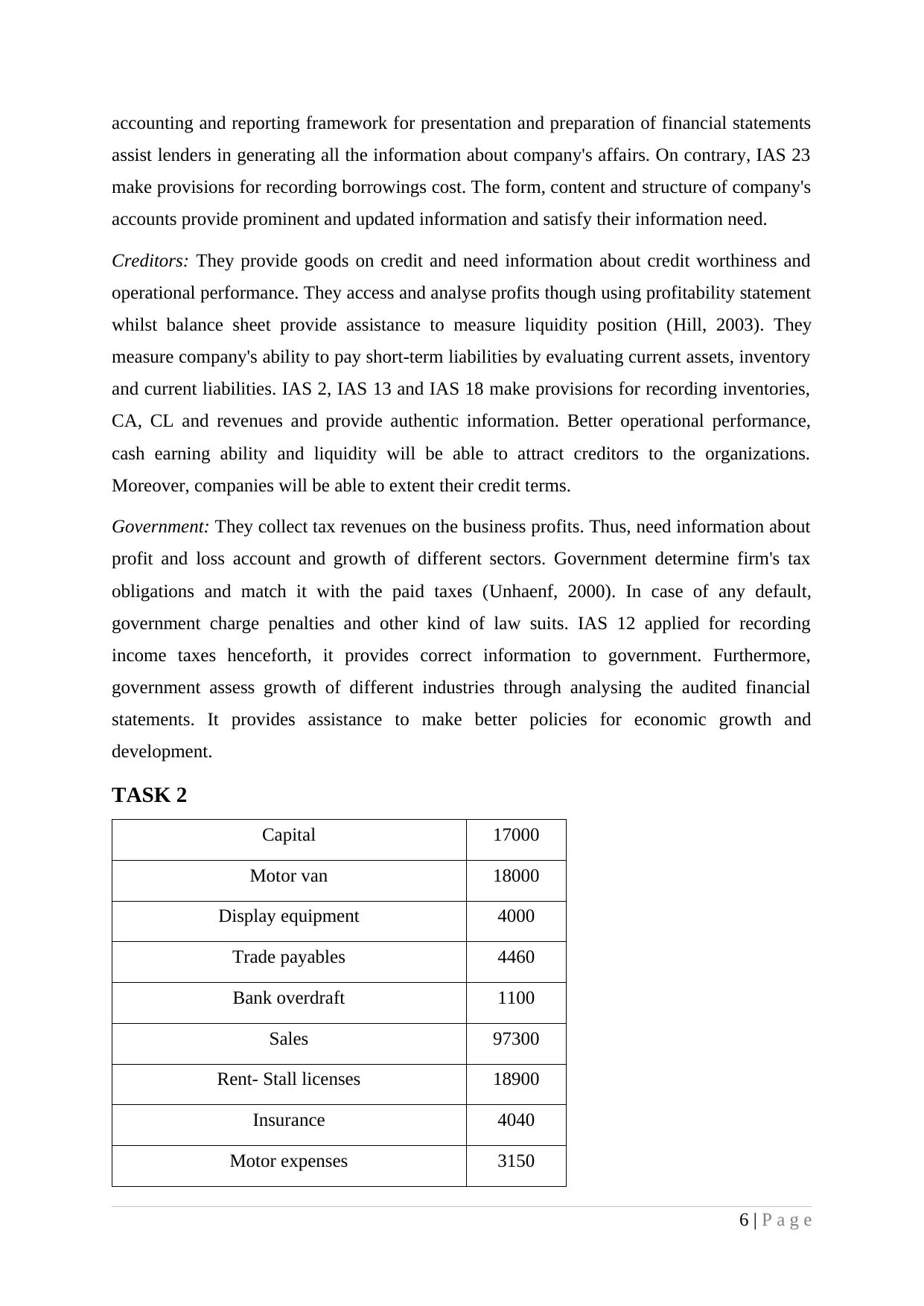
accounting and reporting framework for presentation and preparation of financial statements
assist lenders in generating all the information about company's affairs. On contrary, IAS 23
make provisions for recording borrowings cost. The form, content and structure of company's
accounts provide prominent and updated information and satisfy their information need.
Creditors: They provide goods on credit and need information about credit worthiness and
operational performance. They access and analyse profits though using profitability statement
whilst balance sheet provide assistance to measure liquidity position (Hill, 2003). They
measure company's ability to pay short-term liabilities by evaluating current assets, inventory
and current liabilities. IAS 2, IAS 13 and IAS 18 make provisions for recording inventories,
CA, CL and revenues and provide authentic information. Better operational performance,
cash earning ability and liquidity will be able to attract creditors to the organizations.
Moreover, companies will be able to extent their credit terms.
Government: They collect tax revenues on the business profits. Thus, need information about
profit and loss account and growth of different sectors. Government determine firm's tax
obligations and match it with the paid taxes (Unhaenf, 2000). In case of any default,
government charge penalties and other kind of law suits. IAS 12 applied for recording
income taxes henceforth, it provides correct information to government. Furthermore,
government assess growth of different industries through analysing the audited financial
statements. It provides assistance to make better policies for economic growth and
development.
TASK 2
Capital 17000
Motor van 18000
Display equipment 4000
Trade payables 4460
Bank overdraft 1100
Sales 97300
Rent- Stall licenses 18900
Insurance 4040
Motor expenses 3150
6 | P a g e
assist lenders in generating all the information about company's affairs. On contrary, IAS 23
make provisions for recording borrowings cost. The form, content and structure of company's
accounts provide prominent and updated information and satisfy their information need.
Creditors: They provide goods on credit and need information about credit worthiness and
operational performance. They access and analyse profits though using profitability statement
whilst balance sheet provide assistance to measure liquidity position (Hill, 2003). They
measure company's ability to pay short-term liabilities by evaluating current assets, inventory
and current liabilities. IAS 2, IAS 13 and IAS 18 make provisions for recording inventories,
CA, CL and revenues and provide authentic information. Better operational performance,
cash earning ability and liquidity will be able to attract creditors to the organizations.
Moreover, companies will be able to extent their credit terms.
Government: They collect tax revenues on the business profits. Thus, need information about
profit and loss account and growth of different sectors. Government determine firm's tax
obligations and match it with the paid taxes (Unhaenf, 2000). In case of any default,
government charge penalties and other kind of law suits. IAS 12 applied for recording
income taxes henceforth, it provides correct information to government. Furthermore,
government assess growth of different industries through analysing the audited financial
statements. It provides assistance to make better policies for economic growth and
development.
TASK 2
Capital 17000
Motor van 18000
Display equipment 4000
Trade payables 4460
Bank overdraft 1100
Sales 97300
Rent- Stall licenses 18900
Insurance 4040
Motor expenses 3150
6 | P a g e
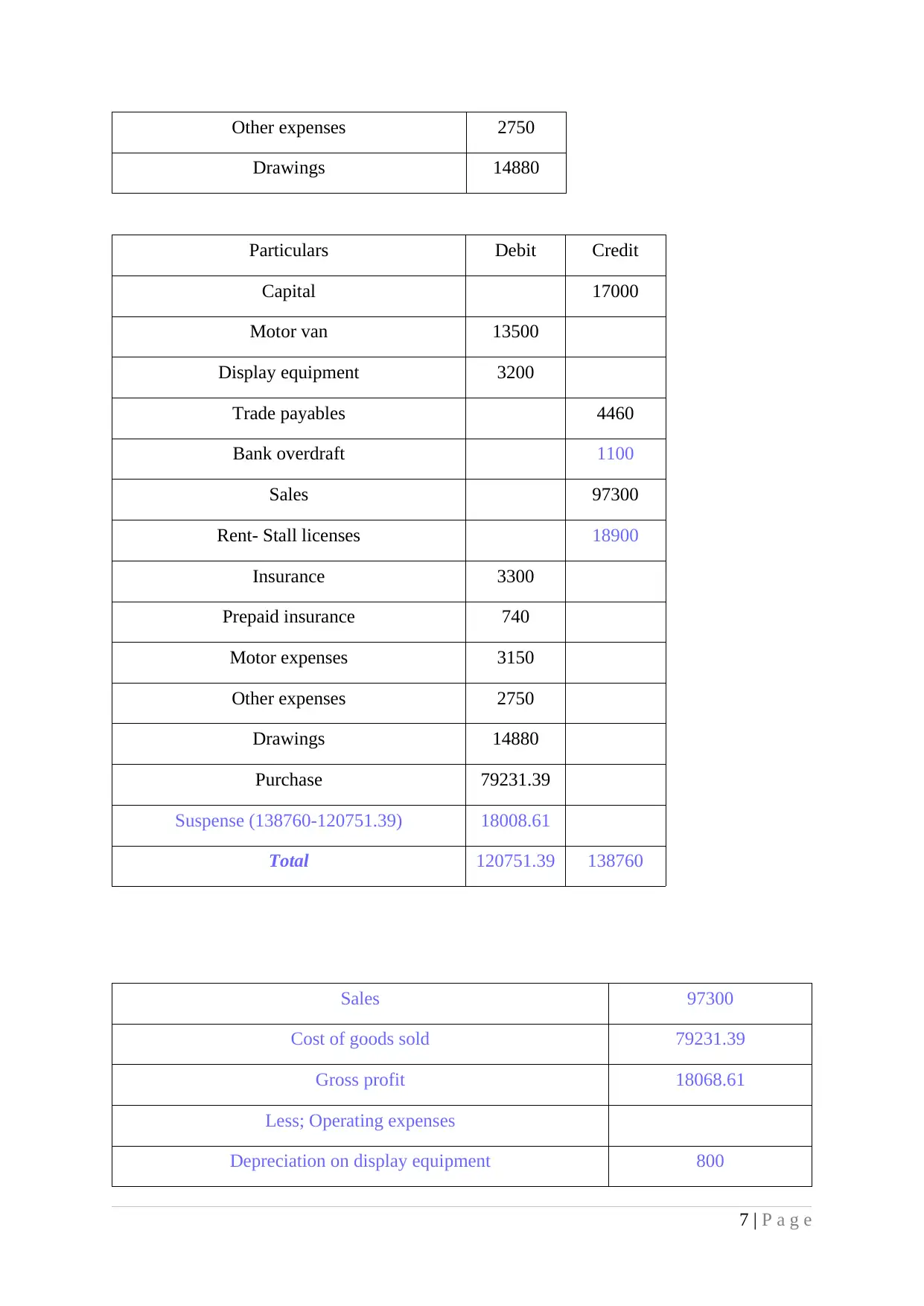
Other expenses 2750
Drawings 14880
Particulars Debit Credit
Capital 17000
Motor van 13500
Display equipment 3200
Trade payables 4460
Bank overdraft 1100
Sales 97300
Rent- Stall licenses 18900
Insurance 3300
Prepaid insurance 740
Motor expenses 3150
Other expenses 2750
Drawings 14880
Purchase 79231.39
Suspense (138760-120751.39) 18008.61
Total 120751.39 138760
Sales 97300
Cost of goods sold 79231.39
Gross profit 18068.61
Less; Operating expenses
Depreciation on display equipment 800
7 | P a g e
Drawings 14880
Particulars Debit Credit
Capital 17000
Motor van 13500
Display equipment 3200
Trade payables 4460
Bank overdraft 1100
Sales 97300
Rent- Stall licenses 18900
Insurance 3300
Prepaid insurance 740
Motor expenses 3150
Other expenses 2750
Drawings 14880
Purchase 79231.39
Suspense (138760-120751.39) 18008.61
Total 120751.39 138760
Sales 97300
Cost of goods sold 79231.39
Gross profit 18068.61
Less; Operating expenses
Depreciation on display equipment 800
7 | P a g e
⊘ This is a preview!⊘
Do you want full access?
Subscribe today to unlock all pages.

Trusted by 1+ million students worldwide
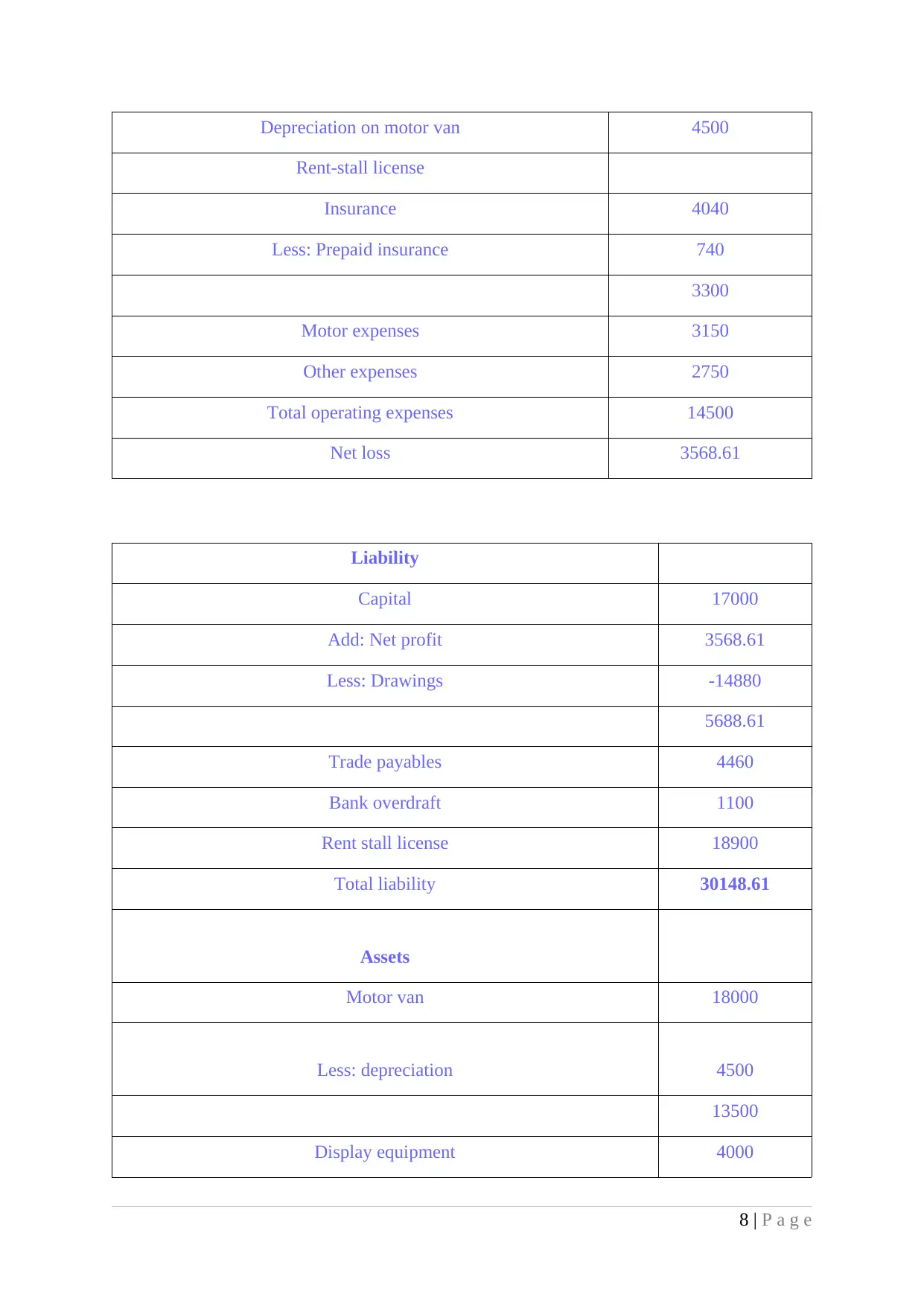
Depreciation on motor van 4500
Rent-stall license
Insurance 4040
Less: Prepaid insurance 740
3300
Motor expenses 3150
Other expenses 2750
Total operating expenses 14500
Net loss 3568.61
Liability
Capital 17000
Add: Net profit 3568.61
Less: Drawings -14880
5688.61
Trade payables 4460
Bank overdraft 1100
Rent stall license 18900
Total liability 30148.61
Assets
Motor van 18000
Less: depreciation 4500
13500
Display equipment 4000
8 | P a g e
Rent-stall license
Insurance 4040
Less: Prepaid insurance 740
3300
Motor expenses 3150
Other expenses 2750
Total operating expenses 14500
Net loss 3568.61
Liability
Capital 17000
Add: Net profit 3568.61
Less: Drawings -14880
5688.61
Trade payables 4460
Bank overdraft 1100
Rent stall license 18900
Total liability 30148.61
Assets
Motor van 18000
Less: depreciation 4500
13500
Display equipment 4000
8 | P a g e
Paraphrase This Document
Need a fresh take? Get an instant paraphrase of this document with our AI Paraphraser
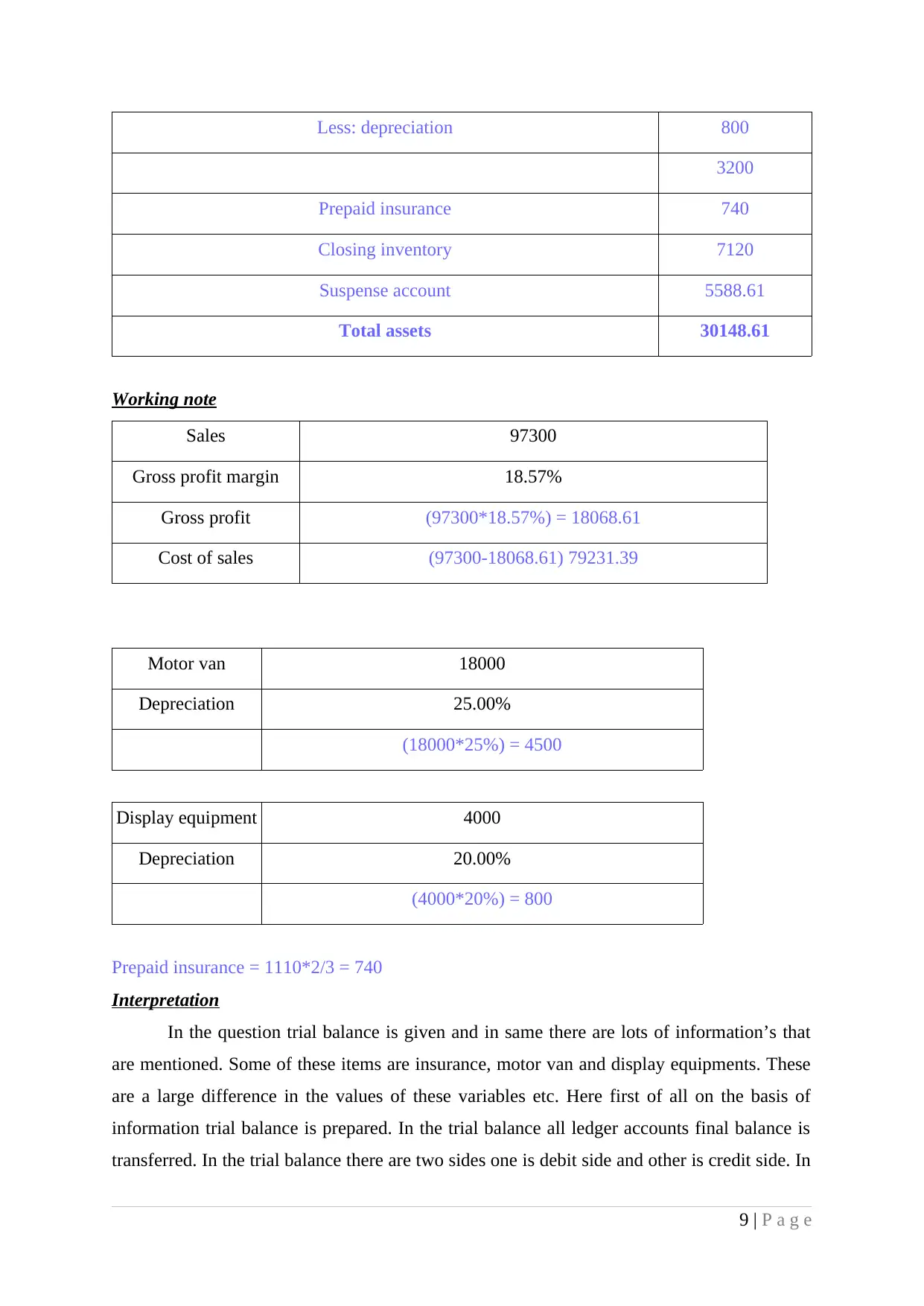
Less: depreciation 800
3200
Prepaid insurance 740
Closing inventory 7120
Suspense account 5588.61
Total assets 30148.61
Working note
Sales 97300
Gross profit margin 18.57%
Gross profit (97300*18.57%) = 18068.61
Cost of sales (97300-18068.61) 79231.39
Motor van 18000
Depreciation 25.00%
(18000*25%) = 4500
Display equipment 4000
Depreciation 20.00%
(4000*20%) = 800
Prepaid insurance = 1110*2/3 = 740
Interpretation
In the question trial balance is given and in same there are lots of information’s that
are mentioned. Some of these items are insurance, motor van and display equipments. These
are a large difference in the values of these variables etc. Here first of all on the basis of
information trial balance is prepared. In the trial balance all ledger accounts final balance is
transferred. In the trial balance there are two sides one is debit side and other is credit side. In
9 | P a g e
3200
Prepaid insurance 740
Closing inventory 7120
Suspense account 5588.61
Total assets 30148.61
Working note
Sales 97300
Gross profit margin 18.57%
Gross profit (97300*18.57%) = 18068.61
Cost of sales (97300-18068.61) 79231.39
Motor van 18000
Depreciation 25.00%
(18000*25%) = 4500
Display equipment 4000
Depreciation 20.00%
(4000*20%) = 800
Prepaid insurance = 1110*2/3 = 740
Interpretation
In the question trial balance is given and in same there are lots of information’s that
are mentioned. Some of these items are insurance, motor van and display equipments. These
are a large difference in the values of these variables etc. Here first of all on the basis of
information trial balance is prepared. In the trial balance all ledger accounts final balance is
transferred. In the trial balance there are two sides one is debit side and other is credit side. In
9 | P a g e
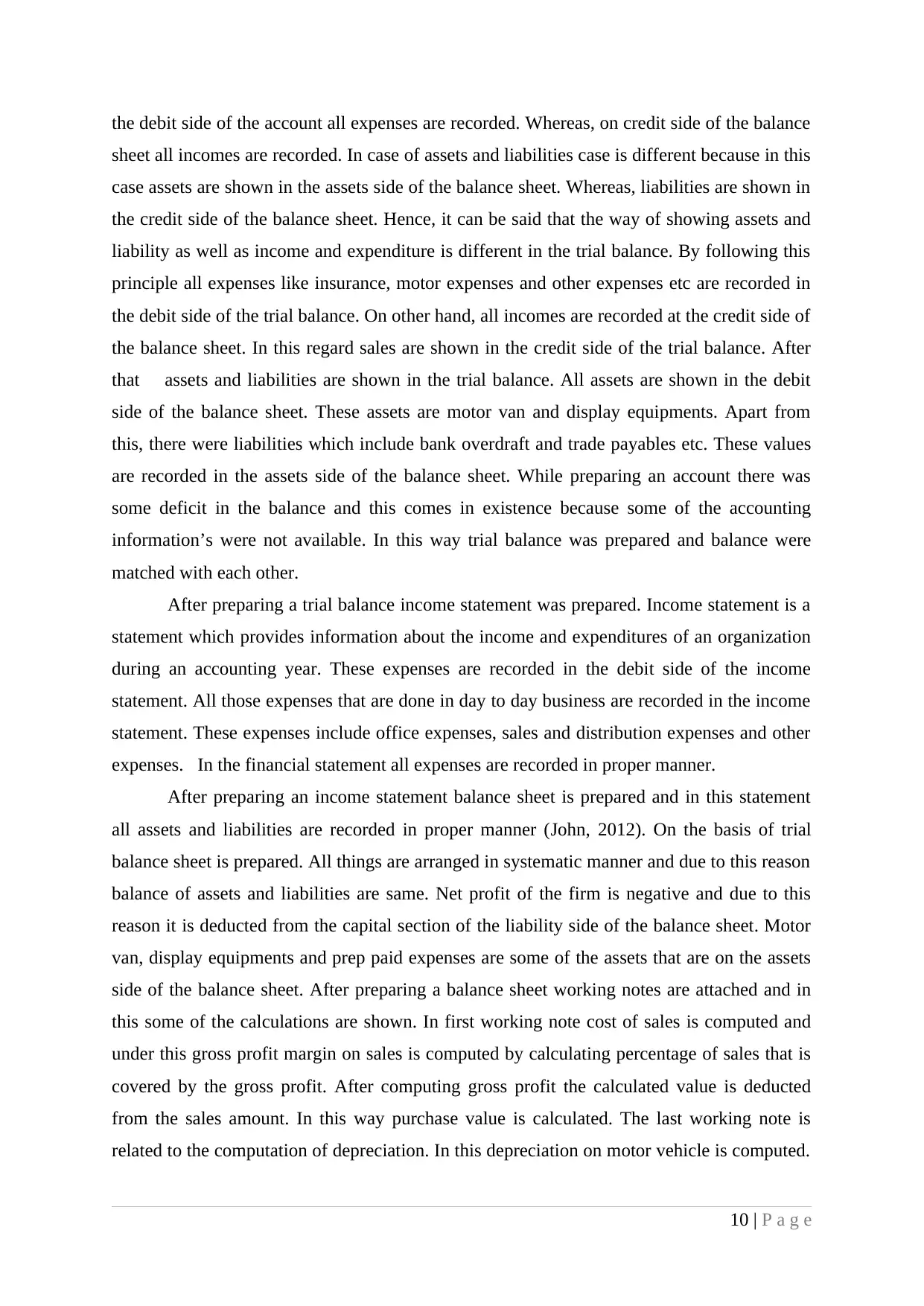
the debit side of the account all expenses are recorded. Whereas, on credit side of the balance
sheet all incomes are recorded. In case of assets and liabilities case is different because in this
case assets are shown in the assets side of the balance sheet. Whereas, liabilities are shown in
the credit side of the balance sheet. Hence, it can be said that the way of showing assets and
liability as well as income and expenditure is different in the trial balance. By following this
principle all expenses like insurance, motor expenses and other expenses etc are recorded in
the debit side of the trial balance. On other hand, all incomes are recorded at the credit side of
the balance sheet. In this regard sales are shown in the credit side of the trial balance. After
that assets and liabilities are shown in the trial balance. All assets are shown in the debit
side of the balance sheet. These assets are motor van and display equipments. Apart from
this, there were liabilities which include bank overdraft and trade payables etc. These values
are recorded in the assets side of the balance sheet. While preparing an account there was
some deficit in the balance and this comes in existence because some of the accounting
information’s were not available. In this way trial balance was prepared and balance were
matched with each other.
After preparing a trial balance income statement was prepared. Income statement is a
statement which provides information about the income and expenditures of an organization
during an accounting year. These expenses are recorded in the debit side of the income
statement. All those expenses that are done in day to day business are recorded in the income
statement. These expenses include office expenses, sales and distribution expenses and other
expenses. In the financial statement all expenses are recorded in proper manner.
After preparing an income statement balance sheet is prepared and in this statement
all assets and liabilities are recorded in proper manner (John, 2012). On the basis of trial
balance sheet is prepared. All things are arranged in systematic manner and due to this reason
balance of assets and liabilities are same. Net profit of the firm is negative and due to this
reason it is deducted from the capital section of the liability side of the balance sheet. Motor
van, display equipments and prep paid expenses are some of the assets that are on the assets
side of the balance sheet. After preparing a balance sheet working notes are attached and in
this some of the calculations are shown. In first working note cost of sales is computed and
under this gross profit margin on sales is computed by calculating percentage of sales that is
covered by the gross profit. After computing gross profit the calculated value is deducted
from the sales amount. In this way purchase value is calculated. The last working note is
related to the computation of depreciation. In this depreciation on motor vehicle is computed.
10 | P a g e
sheet all incomes are recorded. In case of assets and liabilities case is different because in this
case assets are shown in the assets side of the balance sheet. Whereas, liabilities are shown in
the credit side of the balance sheet. Hence, it can be said that the way of showing assets and
liability as well as income and expenditure is different in the trial balance. By following this
principle all expenses like insurance, motor expenses and other expenses etc are recorded in
the debit side of the trial balance. On other hand, all incomes are recorded at the credit side of
the balance sheet. In this regard sales are shown in the credit side of the trial balance. After
that assets and liabilities are shown in the trial balance. All assets are shown in the debit
side of the balance sheet. These assets are motor van and display equipments. Apart from
this, there were liabilities which include bank overdraft and trade payables etc. These values
are recorded in the assets side of the balance sheet. While preparing an account there was
some deficit in the balance and this comes in existence because some of the accounting
information’s were not available. In this way trial balance was prepared and balance were
matched with each other.
After preparing a trial balance income statement was prepared. Income statement is a
statement which provides information about the income and expenditures of an organization
during an accounting year. These expenses are recorded in the debit side of the income
statement. All those expenses that are done in day to day business are recorded in the income
statement. These expenses include office expenses, sales and distribution expenses and other
expenses. In the financial statement all expenses are recorded in proper manner.
After preparing an income statement balance sheet is prepared and in this statement
all assets and liabilities are recorded in proper manner (John, 2012). On the basis of trial
balance sheet is prepared. All things are arranged in systematic manner and due to this reason
balance of assets and liabilities are same. Net profit of the firm is negative and due to this
reason it is deducted from the capital section of the liability side of the balance sheet. Motor
van, display equipments and prep paid expenses are some of the assets that are on the assets
side of the balance sheet. After preparing a balance sheet working notes are attached and in
this some of the calculations are shown. In first working note cost of sales is computed and
under this gross profit margin on sales is computed by calculating percentage of sales that is
covered by the gross profit. After computing gross profit the calculated value is deducted
from the sales amount. In this way purchase value is calculated. The last working note is
related to the computation of depreciation. In this depreciation on motor vehicle is computed.
10 | P a g e
⊘ This is a preview!⊘
Do you want full access?
Subscribe today to unlock all pages.

Trusted by 1+ million students worldwide
1 out of 17
Related Documents
Your All-in-One AI-Powered Toolkit for Academic Success.
+13062052269
info@desklib.com
Available 24*7 on WhatsApp / Email
![[object Object]](/_next/static/media/star-bottom.7253800d.svg)
Unlock your academic potential
Copyright © 2020–2025 A2Z Services. All Rights Reserved. Developed and managed by ZUCOL.





